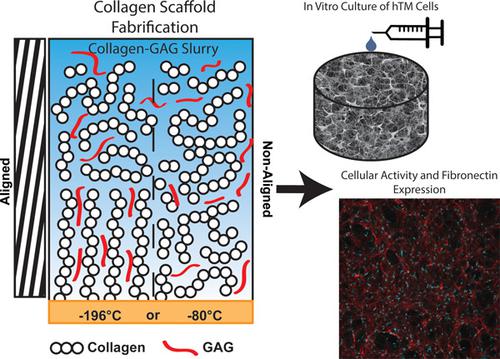当前位置:
X-MOL 学术
›
Biotechnol. Bioeng.
›
论文详情
Our official English website, www.x-mol.net, welcomes your
feedback! (Note: you will need to create a separate account there.)
Human trabecular meshwork cell behavior is influenced by collagen scaffold pore architecture and glycosaminoglycan composition.
Biotechnology and Bioengineering ( IF 3.5 ) Pub Date : 2020-06-26 , DOI: 10.1002/bit.27477 Matthew J Osmond 1 , Melissa D Krebs 1 , Mina B Pantcheva 2
Biotechnology and Bioengineering ( IF 3.5 ) Pub Date : 2020-06-26 , DOI: 10.1002/bit.27477 Matthew J Osmond 1 , Melissa D Krebs 1 , Mina B Pantcheva 2
Affiliation

|
Glaucoma is a degenerative eye disease in which damage to the optic nerve leads to a characteristic loss of vision. The primary risk factor for glaucoma is an increased intraocular pressure that is caused by an imbalance of aqueous humor generation and subsequent drainage through the trabecular meshwork (TM) drainage system. The small size, donor tissue limitations, and high complexity of the TM make it difficult to research the relationship between the TM cells and their immediate environment. Thus, a biomaterial‐based approach may be more appropriate for research manipulations and in vitro drug development platforms. In this work, human TM (hTM) cells were cultured on various collagen scaffolds containing different glycosaminoglycans (GAGs) and different pore architectures to better understand how hTM cells respond to changes in their extracellular environment. Cellular response was measured by quantifying cellular proliferation and expression of an important extracellular matrix protein, fibronectin. The pore architecture of the scaffolds was altered using freeze‐casting technique to make both large and small pores that were aligned or with a non‐aligned random structure. The composition of the scaffolds was altered with the addition of chondroitin sulfate and/or hyaluronic acid. It was found that the hTM cells grown on large pore scaffolds proliferate more than those grown on small pores. There was an increase in the fibronectin expression with the incorporation of GAGs, and its morphology was changed by the underlying pore architecture. This work will help provide an insight into the behavior of hTM cells when introducing changes in their microenvironment.
中文翻译:

人小梁网细胞行为受胶原支架孔结构和糖胺聚糖组成的影响。
青光眼是一种退行性眼病,其中视神经受损导致视力丧失。青光眼的主要危险因素是眼内压升高,这是由房水生成和随后通过小梁网 (TM) 引流系统引流的不平衡引起的。TM 的小尺寸、供体组织限制和高复杂性使得研究 TM 细胞与其直接环境之间的关系变得困难。因此,基于生物材料的方法可能更适合研究操作和体外药物开发平台。在这项工作中,人类 TM (hTM) 细胞在含有不同糖胺聚糖 (GAG) 和不同孔结构的各种胶原支架上培养,以更好地了解 hTM 细胞如何对其细胞外环境的变化做出反应。通过量化细胞增殖和重要细胞外基质蛋白纤连蛋白的表达来测量细胞反应。使用冷冻浇铸技术改变了支架的孔结构,使大孔和小孔均对齐或具有非对齐的随机结构。支架的组成随着硫酸软骨素和/或透明质酸的加入而改变。发现在大孔支架上生长的 hTM 细胞比在小孔上生长的细胞增殖更多。随着 GAG 的掺入,纤连蛋白表达增加,并且其形态被潜在的孔隙结构改变。这项工作将有助于深入了解 hTM 细胞在其微环境中引入变化时的行为。
更新日期:2020-06-26
中文翻译:

人小梁网细胞行为受胶原支架孔结构和糖胺聚糖组成的影响。
青光眼是一种退行性眼病,其中视神经受损导致视力丧失。青光眼的主要危险因素是眼内压升高,这是由房水生成和随后通过小梁网 (TM) 引流系统引流的不平衡引起的。TM 的小尺寸、供体组织限制和高复杂性使得研究 TM 细胞与其直接环境之间的关系变得困难。因此,基于生物材料的方法可能更适合研究操作和体外药物开发平台。在这项工作中,人类 TM (hTM) 细胞在含有不同糖胺聚糖 (GAG) 和不同孔结构的各种胶原支架上培养,以更好地了解 hTM 细胞如何对其细胞外环境的变化做出反应。通过量化细胞增殖和重要细胞外基质蛋白纤连蛋白的表达来测量细胞反应。使用冷冻浇铸技术改变了支架的孔结构,使大孔和小孔均对齐或具有非对齐的随机结构。支架的组成随着硫酸软骨素和/或透明质酸的加入而改变。发现在大孔支架上生长的 hTM 细胞比在小孔上生长的细胞增殖更多。随着 GAG 的掺入,纤连蛋白表达增加,并且其形态被潜在的孔隙结构改变。这项工作将有助于深入了解 hTM 细胞在其微环境中引入变化时的行为。











































 京公网安备 11010802027423号
京公网安备 11010802027423号